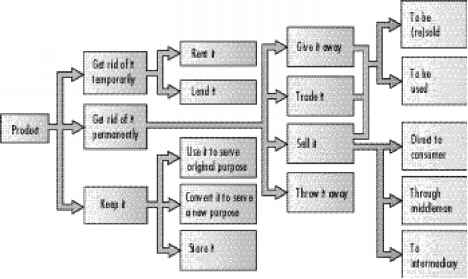Stage 5 Postpurchase Behavior
After purchasing the product, the consumer moves into the final stage of the consumer buying process, in which he or she will experience some level of satisfaction or dissatisfaction. This is why the marketer's job does not end when the product is bought. In particular, marketers must monitor postpurchase satisfaction, postpur-chase actions, and postpurchase product uses.
Postpurchase Satisfaction The buyer's satisfaction with a purchase is a function of the closeness between the buyer's expectations and the product's perceived performance.34 If performance falls short of expectations, the customer is disappointed; if it meets expectations, the customer is satisfied; if it exceeds expectations, the customer is delighted. These feelings of satisfaction influence whether the customer buys the product again and talks favorably or unfavorably about the product to others.
The importance of postpurchase satisfaction suggests that product claims must truthfully represent the product's likely performance. Some sellers might even understate performance levels so that consumers experience higher-than-expected satisfaction with the product.
Postpurchase Actions The consumer's satisfaction or dissatisfaction with the product after purchase will influence subsequent behavior. Satisfied consumers will be more likely to purchase the product again. This has been confirmed by the data on automobile brand choice, which show a high correlation between satisfaction with the last brand bought and intention to rebuy the brand. One survey showed that 75 percent of Toyota buyers were highly satisfied and about 75 percent intended to buy a Toyota again; 35 percent of Chevrolet buyers were highly satisfied and about 35 percent intended to buy a Chevrolet again. Satisfied customers also tend to say good things about the brand to others, which is why many marketers say: "Our best advertisement is a satisfied customer."35
Dissatisfied consumers, on the other hand, may abandon or return the product; seek information that confirms its high value; take public action by complaining to the company, going to a lawyer, or complaining to government agencies and other groups; or take private actions such as not buying the product or warning friends.36 In these cases, the seller has done a poor job of satisfying the customer.37
Marketers can use postpurchase communications to buyers as a way to reduce product returns and order cancellations.38 Computer companies, for example, might take a number of actions, including sending e-mail messages to new buyers congratulating them on having selected a fine computer, placing ads showing satisfied brand owners, soliciting customer suggestions for improvements, and providing channels for speedy resolution of customer complaints.
Postpurchase Use and Disposal Marketers should also monitor how buyers use and dispose of the product after purchase. The various options that are open to consumers are shown in Figure 3-4. If consumers store the product and never use it, the product is probably not very satisfying, and word-of-mouth will not be strong. If they sell or trade the product, new-product sales will be depressed.
Consumers sometimes find new uses for a product, as Avon discovered when its customers talked about Skin-So-Soft bath oil and moisturizer as an insect repellant. This prompted Avon to seek and receive Environmental Protection Agency approval so it could officially tout Skin-So-Soft as a triple-action product that provides insect repellent, waterproof sunscreen, and moisturizers.39
As Figure 3-4 indicates, getting rid of the product permanently leads to a new set of options. If consumers throw the product away, the marketer needs to consider how they dispose of it, especially if it can hurt the environment. For example, increased public awareness of recycling and ecological concerns as well as consumer complaints about having to throw away beautiful bottles led French perfume maker Rochas to

- Figure 3-4 How Consumers Use or Dispose of Products
think about introducing a new, refillable bottle fragrance line. This is a more creative, satisfying response to an element that could potentially cause dissatisfaction among buyers.
Just as firms that target consumers must understand how and why consumers buy, those that target businesses and other organizations must be aware of the differences between consumer and business buying behaviors and the way that businesses make buying decisions. These topics are covered in the next chapter.
Continue reading here: The Buying Center
Was this article helpful?
Readers' Questions
-
katja frei1 year ago
- Reply
-
Salvo Sal1 year ago
- Reply
-
ALYX1 year ago
- Reply
-
PATRICIA1 year ago
- Reply
-
Silke Lehrer1 year ago
- Reply
-
Christine1 year ago
- Reply